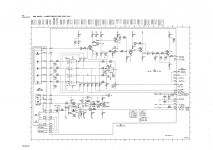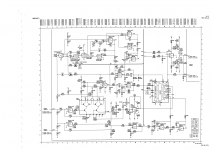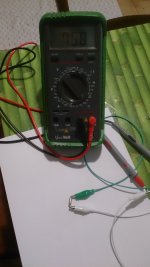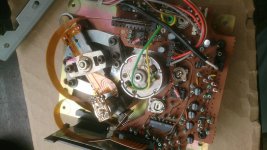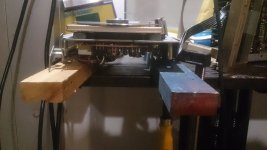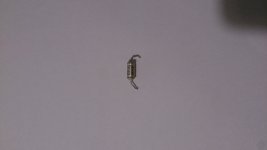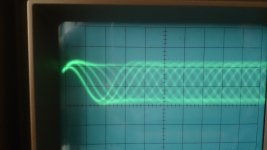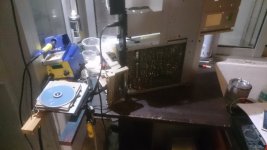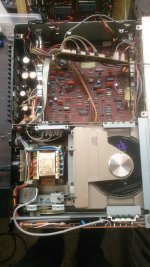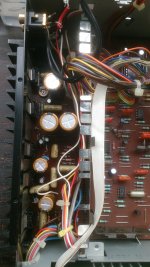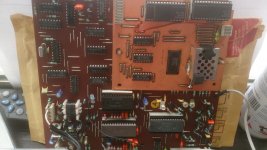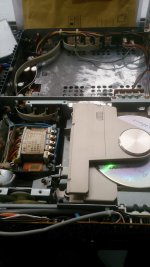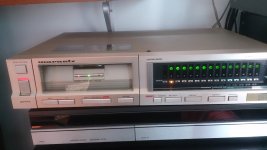So I've been asked to repair a very nice vintage Marantz CD-73, fantastic piece of antique Hi-Fi, in very good optical condition.
I had a hard time disassembling, even though I got SM (for the Marantz it has only schematics, but I've got the manual of the Philips CD303), to get to CDM, but eventually managed and have already put fresh caps for the (in)famous blue axial Philips caps on laser preamp board and tested: no change, not reading.
All supply voltages measure ok. Haven't changed any other caps, though.
This is what the player does: all lights normal, drawer works, disc is loaded, starts to spin, making noises (don't seem bad) from laser, trying to read toc, then fails and makes a whining sound that goes progressively lower in pitch (around 2 sec), while disc starts spinning slower, then gives up, after 1 sec makes a new attempt which goes the same, then quits attempts. Tried several discs - no change.
Without disc, focussing can be observed and laser red dot is well visible with mobile phone, lens doesn't seem dirty.
Measured current delivered to laser (over laser driver transistor emitter resistor) and it seems fine - gives me 66 mA (1,03V over resistor).
Have checked laser preamp board for bad solder joints, all fine, or components looking bad, nothing, also measured all transistors and caps (as I only changed the electrolytics), all measure fine.
Checked voltages against SM - almost perfect, except one of them, IC6114A has -5,2V at pin 4, while in SM supposedly it should have -7. Btw, this is LM358 as opposed to NE532 in SM).
Outputs of IC6101 (photodiode array preamp) all show a little negative offset (-0,08V instead of 0V mentioned in SM), but I guess that can be normal?
Now comes the thing: while verifying adjustments, I noticed that I can't measure voltage for laser current control as described in SM: I probe at resistor 3308 as described, and it always is around 20mV, no change when laser goes on!!
So, I started measuring voltages at servo board (which unfortunately I haven't disassembled yet, this player is hard to service, you need a lot of space), I'm measuring from solder side. And here I get odd values:
1) At IC6214 (LM324) output pin 1, SM says -7,1V when STOP, +1 V when playing.
It measures around -0,5V, no matter if I hit "PLAY", there's no change.
2) At IC6215 (LM324) output pin 14, SM says: -11,4V when STOP and -0,3V when PLAY.
It measures -3V when STOP and gets -4V when I hit Play, while it is briefly trying to read.
Also, at output pin 7 of IC6214, the voltage doesn't change between STOP and trying to read, stays at 0,5V.
Now, something even more odd: I thought, maybe the LM324 are "toast", because the solder of their pins seems different from the rest of the board, seems someone did a repair here before, so I DISCONNECTED the radial/focus error connector from laser preamp board and measured the same places:
1) gets -8V
2) gets -11V
Which are pretty close to values from SM... obviously I didn't try to hit PLAY
What can be going on here?? If radial error output is taken from photodiode preamp (which I can measure around -0,07V at each output), it combines two outputs with resistors, how can that signal cause the voltage to sink at both outputs of two different LM324? I haven't scope this, only DMM, maybe some oscillation?
Any hints here, please? Can this be normal, might I be chasing a ghost, I mean, maybe wrong indications in SM, and all the drive might need is turntable height correction? or some other adjustment (other than laser, which appears fine)? or mechanical problems, like swing arm not moving well enough (it seems free, but not perfect, sometimes seems to "stay" at one of the extremes. I don't want to mess around with the CDM, which I understand is much more complex than the later ones (which I know pretty well to service), if not needed, if this is a electronic problem.
Might this indicate some weird electronic problem, probably in laser preamp board? Or the LM324's on servo board? Would it be able to "test" them, simulating some kind of radial error input? or even just normal test signals? I'm kind of against just swapping some IC "because of a suspect voltage". Also, I can't do complete recap to servo board before knowing if I can fix the player, as this is paid task (but only if I succeed lol...).
Thanks for any hints in advance!
I had a hard time disassembling, even though I got SM (for the Marantz it has only schematics, but I've got the manual of the Philips CD303), to get to CDM, but eventually managed and have already put fresh caps for the (in)famous blue axial Philips caps on laser preamp board and tested: no change, not reading.
All supply voltages measure ok. Haven't changed any other caps, though.
This is what the player does: all lights normal, drawer works, disc is loaded, starts to spin, making noises (don't seem bad) from laser, trying to read toc, then fails and makes a whining sound that goes progressively lower in pitch (around 2 sec), while disc starts spinning slower, then gives up, after 1 sec makes a new attempt which goes the same, then quits attempts. Tried several discs - no change.
Without disc, focussing can be observed and laser red dot is well visible with mobile phone, lens doesn't seem dirty.
Measured current delivered to laser (over laser driver transistor emitter resistor) and it seems fine - gives me 66 mA (1,03V over resistor).
Have checked laser preamp board for bad solder joints, all fine, or components looking bad, nothing, also measured all transistors and caps (as I only changed the electrolytics), all measure fine.
Checked voltages against SM - almost perfect, except one of them, IC6114A has -5,2V at pin 4, while in SM supposedly it should have -7. Btw, this is LM358 as opposed to NE532 in SM).
Outputs of IC6101 (photodiode array preamp) all show a little negative offset (-0,08V instead of 0V mentioned in SM), but I guess that can be normal?
Now comes the thing: while verifying adjustments, I noticed that I can't measure voltage for laser current control as described in SM: I probe at resistor 3308 as described, and it always is around 20mV, no change when laser goes on!!
So, I started measuring voltages at servo board (which unfortunately I haven't disassembled yet, this player is hard to service, you need a lot of space), I'm measuring from solder side. And here I get odd values:
1) At IC6214 (LM324) output pin 1, SM says -7,1V when STOP, +1 V when playing.
It measures around -0,5V, no matter if I hit "PLAY", there's no change.
2) At IC6215 (LM324) output pin 14, SM says: -11,4V when STOP and -0,3V when PLAY.
It measures -3V when STOP and gets -4V when I hit Play, while it is briefly trying to read.
Also, at output pin 7 of IC6214, the voltage doesn't change between STOP and trying to read, stays at 0,5V.
Now, something even more odd: I thought, maybe the LM324 are "toast", because the solder of their pins seems different from the rest of the board, seems someone did a repair here before, so I DISCONNECTED the radial/focus error connector from laser preamp board and measured the same places:
1) gets -8V
2) gets -11V
Which are pretty close to values from SM... obviously I didn't try to hit PLAY
What can be going on here?? If radial error output is taken from photodiode preamp (which I can measure around -0,07V at each output), it combines two outputs with resistors, how can that signal cause the voltage to sink at both outputs of two different LM324? I haven't scope this, only DMM, maybe some oscillation?
Any hints here, please? Can this be normal, might I be chasing a ghost, I mean, maybe wrong indications in SM, and all the drive might need is turntable height correction? or some other adjustment (other than laser, which appears fine)? or mechanical problems, like swing arm not moving well enough (it seems free, but not perfect, sometimes seems to "stay" at one of the extremes. I don't want to mess around with the CDM, which I understand is much more complex than the later ones (which I know pretty well to service), if not needed, if this is a electronic problem.
Might this indicate some weird electronic problem, probably in laser preamp board? Or the LM324's on servo board? Would it be able to "test" them, simulating some kind of radial error input? or even just normal test signals? I'm kind of against just swapping some IC "because of a suspect voltage". Also, I can't do complete recap to servo board before knowing if I can fix the player, as this is paid task (but only if I succeed lol...).
Thanks for any hints in advance!
Attachments
Sounds like this would be a lot easier with a scope.
Well, maybe
Well this is pretty amazing: I got it to play!!! And it was kind of an "accident":
as I was preparing a suitable position to be able to scope the signals, I put the CDM on the open drawer, connected cables and with the player open (in horizontal position), I needed something to secure the CD to the turntable, as I couldn't use the normal clamp in this situation, I got myself a round magnet which was used in some portable CD player and it perfectly fixes the CD in place. Then, just for the sake of it, and to test if CD is well fixed (even before getting my scope out), I switched it on and noticed that the reading efforts sounded different this time, suddenly lights changed, it indicated number of tracks and stopped! It had read TOC! I pushed play and it started to play, track change to next track also worked without problems! It's just ONE pressed CD I used for now, and haven't even tried to see if I get sound, also, but at least the CD reading is proved working now, which is a major breakthrough.
Now, I'll get my scope and measure all signals I can (the problem is: now I can't get to the signals I was measuring before, they are below the player where I can't get in this position. Any idea if the player accepts vertical position?), like eye pattern, radial and focus error, etc.
So, it seems, after all, it would be having some kind of mechanical issue (like I was thinking, but those strange measurements got me confused), possibly with the motor? Or would it be the clamp?
Or, and this one would be interesting: is it possible that in the end the problem really was one of these electrolytic caps on the laser board? Because, when I was testing it yesterday after recapping that board, I didn't mount the disc clamp as originally, tried to fix it in acceptable manner (I've done this with other CDMs), but maybe this one is not well adjusted, needing perfect clamping (as it's done with the magnet now) and therefore it was failing? Could be turntable height, if it was needing just a fraction of mm lower, then maybe this magnet would be sufficient weight to keep it "low" within the little play the motor might have?
I'm pretty sure I will find out. But the best part is: I'm confident that I'm going to be able to fix it definitely.
I absolutely will read all I can about maintainance of this beautiful mech before servicing it, so I don't make any mistakes. And I will only touch what's needed, as I understand these mechs are hard to adjust without proper rigs like they had in factory.
as I was preparing a suitable position to be able to scope the signals, I put the CDM on the open drawer, connected cables and with the player open (in horizontal position), I needed something to secure the CD to the turntable, as I couldn't use the normal clamp in this situation, I got myself a round magnet which was used in some portable CD player and it perfectly fixes the CD in place. Then, just for the sake of it, and to test if CD is well fixed (even before getting my scope out), I switched it on and noticed that the reading efforts sounded different this time, suddenly lights changed, it indicated number of tracks and stopped! It had read TOC! I pushed play and it started to play, track change to next track also worked without problems! It's just ONE pressed CD I used for now, and haven't even tried to see if I get sound, also, but at least the CD reading is proved working now, which is a major breakthrough.
Now, I'll get my scope and measure all signals I can (the problem is: now I can't get to the signals I was measuring before, they are below the player where I can't get in this position. Any idea if the player accepts vertical position?), like eye pattern, radial and focus error, etc.
So, it seems, after all, it would be having some kind of mechanical issue (like I was thinking, but those strange measurements got me confused), possibly with the motor? Or would it be the clamp?
Or, and this one would be interesting: is it possible that in the end the problem really was one of these electrolytic caps on the laser board? Because, when I was testing it yesterday after recapping that board, I didn't mount the disc clamp as originally, tried to fix it in acceptable manner (I've done this with other CDMs), but maybe this one is not well adjusted, needing perfect clamping (as it's done with the magnet now) and therefore it was failing? Could be turntable height, if it was needing just a fraction of mm lower, then maybe this magnet would be sufficient weight to keep it "low" within the little play the motor might have?
I'm pretty sure I will find out. But the best part is: I'm confident that I'm going to be able to fix it definitely.
I absolutely will read all I can about maintainance of this beautiful mech before servicing it, so I don't make any mistakes. And I will only touch what's needed, as I understand these mechs are hard to adjust without proper rigs like they had in factory.
Put it on its side, and now the measurements make more sense. Seems that laser adjust measurement across R3308 is only possible when its actually reading/playing, differently from CDM-2 or 4 for example, where measurement can be done even while initial focus action. I measure 580 - 670 mV, higher value is when its struggling, yes, it doesn't read correctly when vertical on its side. I've seen a Philips CD303 on YouTube playing in that position, so I guess that's not the best sign.
This value seems on the high side, shall I lower it to 550? Haven't done any other measurements yet, but I think this player needs servicing of the mechanical bits and a proper adjustment. Will report back when more progress.
This value seems on the high side, shall I lower it to 550? Haven't done any other measurements yet, but I think this player needs servicing of the mechanical bits and a proper adjustment. Will report back when more progress.
just take the lid off and use your fingers to push different places on the drive. You will hear from the sound when it reads perfectly. Then just put some weight instead of your fingers. Maybe use rubberband or something to keep it fixed. I did this succesfully a couple of times. Enjoy!
Cheers!
Cheers!
Progress so far:
- got the drive supported outside of player in almost horizontal position and player vertical, so I can measure servo board test points. It only plays CD-R now, what a weird situation. Couldn't get it to play pressed CDs, but haven't tried many different. The CD-R that it plays goes quite well, track changes work until close to end, then sometimes fails and swing arm slowly goes back until finding track again. But seemed to improve after some attempts, so needs cleaning and lubrification.
Results with scope:
- eye pattern looks good, CD-R produces 1,1V, and pressed CD briefly focussed and I saw about 1,5Vpp.
- radial and focus error signals look normal, as far as I can tell. When focus is lost (or not found), they go "crazy" as I've seen before
- supply rails have no high ripple or bad noise, all normal.
- when the focus is not found on pressed CD, eye pattern is very blurry and unstable, but I think that's normal.
Adjustments: checked laser adjustment carefully, while looking at eye pattern. With CD-R, strangely enough, it is lower, settled at 550mV, it was a bit higher before, as I already wrote before. Tried lowering to 450, eye pattern got lower, reading got worse, higher (got it briefly at 700) doesn't help, so put it back to safe value.
Checked Focus Gain adjustment - trying to adjust to one side would make reading less noisy but eventualy focus lost and laser off, to other side it starts to "tick", so settled in the middle.
Now, to the strange parts:
- when doing track changes, it is quite slow, radial swing arm makes noise like this:
"ta-ta-ta-ti-ti-ti-titititiii---” and then track change is complete and new track is playing. The green track LED of the new track follows the strange fast "tititi" shortly before settling at the new track. I'm pretty sure that's not normal - just had a look at video on Youtube of CD-73 and it not only changes more quicker, noise is more like "ta-ta-ta-ti", also no "tititi" and no LED flashing, it smoothly goes from one to the other. What could this be? Can't imagine this is caused by "sticky" or unbalanced swing arm or can it?
- the voltages that I "complained" above about not being like in SM - they are still wrong in STOP position. When playing, they are OK...
So, any ideas? why does it read CD-R and not pressed CD?
Why are the track changes so weird?
Why are the voltages off from SM?
My plan now is: clean and lubricate swing arm and maybe disc motor, if possible, trying not to disturb mechanical adjustments, if possible. There's plenty of documentation of this on the net.
What's left, too, would be changing some electrolytics (and later, complete recap if player is on the way to being fixed) on servo board.
- got the drive supported outside of player in almost horizontal position and player vertical, so I can measure servo board test points. It only plays CD-R now, what a weird situation. Couldn't get it to play pressed CDs, but haven't tried many different. The CD-R that it plays goes quite well, track changes work until close to end, then sometimes fails and swing arm slowly goes back until finding track again. But seemed to improve after some attempts, so needs cleaning and lubrification.
Results with scope:
- eye pattern looks good, CD-R produces 1,1V, and pressed CD briefly focussed and I saw about 1,5Vpp.
- radial and focus error signals look normal, as far as I can tell. When focus is lost (or not found), they go "crazy" as I've seen before
- supply rails have no high ripple or bad noise, all normal.
- when the focus is not found on pressed CD, eye pattern is very blurry and unstable, but I think that's normal.
Adjustments: checked laser adjustment carefully, while looking at eye pattern. With CD-R, strangely enough, it is lower, settled at 550mV, it was a bit higher before, as I already wrote before. Tried lowering to 450, eye pattern got lower, reading got worse, higher (got it briefly at 700) doesn't help, so put it back to safe value.
Checked Focus Gain adjustment - trying to adjust to one side would make reading less noisy but eventualy focus lost and laser off, to other side it starts to "tick", so settled in the middle.
Now, to the strange parts:
- when doing track changes, it is quite slow, radial swing arm makes noise like this:
"ta-ta-ta-ti-ti-ti-titititiii---” and then track change is complete and new track is playing. The green track LED of the new track follows the strange fast "tititi" shortly before settling at the new track. I'm pretty sure that's not normal - just had a look at video on Youtube of CD-73 and it not only changes more quicker, noise is more like "ta-ta-ta-ti", also no "tititi" and no LED flashing, it smoothly goes from one to the other. What could this be? Can't imagine this is caused by "sticky" or unbalanced swing arm or can it?
- the voltages that I "complained" above about not being like in SM - they are still wrong in STOP position. When playing, they are OK...
So, any ideas? why does it read CD-R and not pressed CD?
Why are the track changes so weird?
Why are the voltages off from SM?
My plan now is: clean and lubricate swing arm and maybe disc motor, if possible, trying not to disturb mechanical adjustments, if possible. There's plenty of documentation of this on the net.
What's left, too, would be changing some electrolytics (and later, complete recap if player is on the way to being fixed) on servo board.
"clean and lubricate swing arm and maybe disc motor, if possible" - This, and if that doesnt fix problem, best try to to disturb mechanics. Better not disturb electronics when not needed. I suspect you accidentically touched some laseradjusments. Thats why it only reads cdr now.
Edit: Best keep all parts of the player horisontal. That might help the cdr weirdness too.
Cheers!
Edit: Best keep all parts of the player horisontal. That might help the cdr weirdness too.
Cheers!
Last edited:
I didn't "disturb the electronics" as you call it, and I didn't touch accidentally any adjustments, especially of the laser... I've fixed well over 15 cd players up to today and I always avoid to adjust when not needed, and if I adjust, I always measure and follow SM indications and if possible (that's what I did here), look at eye pattern at the same time. Laser current is pretty close to what it was before (it was kind of high, according to specs from SM), but I even put it exactly to where it was before, to test, and this didn't make any change at all regarding reading of pressed CDs, so I'm pretty sure that's not the explanation. I remember reading on this forum a thread where someone had the exact same problem but I can't find it, so this seems to happens sometimes and I think has to do with different reflective characteristics of CD-R compared to pressed disc.
This page has some very good explanation on how to service without risking too much or having to do difficult mechanical adjustments, so I'm going to follow the important steps there next, as I said, it might very well solve all issues, let's see.
It's just that the voltages don't match the service manual, as I said, but this might even be a mistake in SM, this happens sometimes, that's why I put this here, thinking that someone might have run into the same issue.
This page has some very good explanation on how to service without risking too much or having to do difficult mechanical adjustments, so I'm going to follow the important steps there next, as I said, it might very well solve all issues, let's see.
It's just that the voltages don't match the service manual, as I said, but this might even be a mistake in SM, this happens sometimes, that's why I put this here, thinking that someone might have run into the same issue.
I found the problem!!! Have kind of very little time right now to post this, so just a quick note that the problem is localized, player reads great now. It was a tiny cap in the wobble oscillator which had dry solder joints, making it open circuit so the whole oscillator was knocked out! Without wobble oscillator, the tracking and error correction is totally compromised, so it would work in a limited way, but only on very good pressed CD, as the tracks are narrower than CD-R, where it would work "Kind of"! ! It all makes sense now!!! Later I will post how I found the problem and what I learned with this repair.
So, this is what I did and how I found the problem:
- I followed the advice (and common sense, taking into account age of player) here and on other places and cleaned and lubricated the swing arm (carefully, so not to take it totally apart), it now swings much more freely. I tried to lubricate the spindle motor, but was unable to get oil into it (no holes in bottom, top is inaccessible due to "turntable"). This improved reading on outer tracks of CD, it would "lose tracking" and return to track 1 before much more easily
- I adjusted the spindle motor height via its screw in the motor shaft (focus adjustment), following SM indications (measuring voltage at 3240 and also watching eye pattern on scope), BUT: even though I set it almost perfect, it would never get right for all CDs. The CD-R was most tolerant. Two pressed (good condition) CDs I tried, when one was acceptable (still very sensitive to mechanical impact), the other failed, and vice-versa.
- I tried again to check laser adjustment (watching eye pattern and control voltage at 3308), was fine. Had no influence, unless set too low.
- played with focus gain pot, not really useful, no real difference.
- discovered (by accident) that connecting the metal frame of CDM to case of player (ground) would improve reading. Very odd. This made me think - it HAD to be a problem in electronics.
- I then came across a part in SM where it said: if the offset and error correction circuits are defective, the player might function acceptably with a very good condition CD, but fail with minimal errors or mechanical impact. This made me think again and I started to measure around on servo board, comparing voltages to SM indications.
I quickly noticed something was really wrong around IC6212 and IC6213, which together form the wobble oscillator. IC6212 was outputting 10,8V DC at pin 8 and at pin 9 there was only 1,25V and also at pins 10 and 8 of IC6213 there was 5V instead of 2,5V. Also, there was NO 650Hz signal at all! So, no wobble signal! That explained EVERYTHING!
Voltages at other parts of these ICs were fine, this made very unlikely that the ICs would have failed, so I started measuring passive components.
The wobble oscillator contains two 1% caps, I remembered reading that they tend to fail. But no, they were fine. As were the resistors. But then I measured C2237 (33nF) and yes, it gave weird values of fluctuating low capacity on my DMM! Then it struck me: it was one of a few components which had "dark" dots (little cavities?) in the middle of the solder joint (which would only be visible with little light), as basically the end of their leg had corroded a little, making it appear in a different color compared to the solder joint (which wasn't dry). I had noticed them before, but the ones that I measured were fine. I missed this one! If I had measured before, I'd got to the problem many hours before...
I resoldered the legs, and yes, now 33nF! So, I switched player on and BINGO! On my scope I now could see 650Hz signal at test points of wobble osc and now read perfectly all the CDs I threw at it!
What I've got left to do with the player: resolder the other few components with "darkened" legs, seal radial arm nut with nail laquer, tighten correctly spindle motor security nut, give it a good clean and (hopefully I will get green light from owner) do a comprehensive recap, maybe not complete, but at least the power supply, audio signal path and nasty blue axial Philips caps... Then, I'm sure it will work well another 20 years, if well treated! These old mechanisms and lasers are superb.
I will report back then and post some photos.
- I followed the advice (and common sense, taking into account age of player) here and on other places and cleaned and lubricated the swing arm (carefully, so not to take it totally apart), it now swings much more freely. I tried to lubricate the spindle motor, but was unable to get oil into it (no holes in bottom, top is inaccessible due to "turntable"). This improved reading on outer tracks of CD, it would "lose tracking" and return to track 1 before much more easily
- I adjusted the spindle motor height via its screw in the motor shaft (focus adjustment), following SM indications (measuring voltage at 3240 and also watching eye pattern on scope), BUT: even though I set it almost perfect, it would never get right for all CDs. The CD-R was most tolerant. Two pressed (good condition) CDs I tried, when one was acceptable (still very sensitive to mechanical impact), the other failed, and vice-versa.
- I tried again to check laser adjustment (watching eye pattern and control voltage at 3308), was fine. Had no influence, unless set too low.
- played with focus gain pot, not really useful, no real difference.
- discovered (by accident) that connecting the metal frame of CDM to case of player (ground) would improve reading. Very odd. This made me think - it HAD to be a problem in electronics.
- I then came across a part in SM where it said: if the offset and error correction circuits are defective, the player might function acceptably with a very good condition CD, but fail with minimal errors or mechanical impact. This made me think again and I started to measure around on servo board, comparing voltages to SM indications.
I quickly noticed something was really wrong around IC6212 and IC6213, which together form the wobble oscillator. IC6212 was outputting 10,8V DC at pin 8 and at pin 9 there was only 1,25V and also at pins 10 and 8 of IC6213 there was 5V instead of 2,5V. Also, there was NO 650Hz signal at all! So, no wobble signal! That explained EVERYTHING!
Voltages at other parts of these ICs were fine, this made very unlikely that the ICs would have failed, so I started measuring passive components.
The wobble oscillator contains two 1% caps, I remembered reading that they tend to fail. But no, they were fine. As were the resistors. But then I measured C2237 (33nF) and yes, it gave weird values of fluctuating low capacity on my DMM! Then it struck me: it was one of a few components which had "dark" dots (little cavities?) in the middle of the solder joint (which would only be visible with little light), as basically the end of their leg had corroded a little, making it appear in a different color compared to the solder joint (which wasn't dry). I had noticed them before, but the ones that I measured were fine. I missed this one! If I had measured before, I'd got to the problem many hours before...
I resoldered the legs, and yes, now 33nF! So, I switched player on and BINGO! On my scope I now could see 650Hz signal at test points of wobble osc and now read perfectly all the CDs I threw at it!
What I've got left to do with the player: resolder the other few components with "darkened" legs, seal radial arm nut with nail laquer, tighten correctly spindle motor security nut, give it a good clean and (hopefully I will get green light from owner) do a comprehensive recap, maybe not complete, but at least the power supply, audio signal path and nasty blue axial Philips caps... Then, I'm sure it will work well another 20 years, if well treated! These old mechanisms and lasers are superb.
I will report back then and post some photos.
Thanks 
But the task is not done yet: now that it's reading nicely, I tried it out connected to amp, and noticed that only one channel is playing muisc! Probably a bad cap or bad solder joint. Owner gave me green light to do a (almost) full recap, so still a lot to do, but now I'm confident it will be restored to great condition.
But the task is not done yet: now that it's reading nicely, I tried it out connected to amp, and noticed that only one channel is playing muisc! Probably a bad cap or bad solder joint. Owner gave me green light to do a (almost) full recap, so still a lot to do, but now I'm confident it will be restored to great condition.
Well, I'm now almost done with the recap. But this had a surprising (and unnerving) turnaround in the meanwhile: the damn wobble oscillator failure occurred again, suddenly! And it would go away and come back intermittently, as I would "resolder things" around the wobble oscillator section (heat/cold).
I was getting desperate, decided taking out one or another leg of resistors so to isolate the problem, which didn't help, as I was now suspecting (wrongly) of the LM324, which I unsoldered and replaced with a new one, just to see the same exact wrong 10,3V on pin 8 and NO wobble signal! I also resoldered the 33nF cap again, nothing. Just before starting to (wrongly) suspect of the 4070 IC, and having tested all resistors, I measured again all voltages in the surroundings and started thinking. And by deduction it suddenly struck me: no way that there could be 5V at pin 10 of 4070 and around 0,6V after the 120k resistor R323, and this made me focus on the two 1% film caps (5,6n) which are part of the wobble oscillator and are of the flimsy old type which I heard before does sometimes go open or short! And YES! one of them measured 22k-80k widely floating according to temperature/position of the moon?? lol... it would short against ground, so no oscillation possible!
Strangely enough, it would still measure with acceptable capacity on my DMM! That's why I wouldn't find it before, I had measured it before!
Below are some photos were you can see the bad boy. And yes, only one of them was bad!
I changed them and bingo! All voltages normal and stable and perfectly reading all discs.
I then proceed and tested again and don't know why, but now audio output is fine on both channels, player is working! So I went ahead with the recap which is almost done (and tested, doing it in parts). Oddly enough, while doing the recap (as this player is kind of hard to service, just have a look at the complicated work bench setup), one lead of the HF cable just broke off the PCB and made me live half an hour of "panic", as the player would now totally refuse to read! Then I noticed the broken wire! Always pay attention to details and bend old cables as little as possible...
Will make final report and some more photos when all is done and back together.
I was getting desperate, decided taking out one or another leg of resistors so to isolate the problem, which didn't help, as I was now suspecting (wrongly) of the LM324, which I unsoldered and replaced with a new one, just to see the same exact wrong 10,3V on pin 8 and NO wobble signal! I also resoldered the 33nF cap again, nothing. Just before starting to (wrongly) suspect of the 4070 IC, and having tested all resistors, I measured again all voltages in the surroundings and started thinking. And by deduction it suddenly struck me: no way that there could be 5V at pin 10 of 4070 and around 0,6V after the 120k resistor R323, and this made me focus on the two 1% film caps (5,6n) which are part of the wobble oscillator and are of the flimsy old type which I heard before does sometimes go open or short! And YES! one of them measured 22k-80k widely floating according to temperature/position of the moon?? lol... it would short against ground, so no oscillation possible!
Strangely enough, it would still measure with acceptable capacity on my DMM! That's why I wouldn't find it before, I had measured it before!
Below are some photos were you can see the bad boy. And yes, only one of them was bad!
I changed them and bingo! All voltages normal and stable and perfectly reading all discs.
I then proceed and tested again and don't know why, but now audio output is fine on both channels, player is working! So I went ahead with the recap which is almost done (and tested, doing it in parts). Oddly enough, while doing the recap (as this player is kind of hard to service, just have a look at the complicated work bench setup), one lead of the HF cable just broke off the PCB and made me live half an hour of "panic", as the player would now totally refuse to read! Then I noticed the broken wire! Always pay attention to details and bend old cables as little as possible...
Will make final report and some more photos when all is done and back together.
Attachments
So,here's the final report, player is reassembled and working great, playing Pat Metheny right now 
I'll be kind of sad when it will go back to its owner, haven't had anything like this here before yet... it's a real museum piece now.
It even plays CD-Rs, which is amazing, because this is CDM-0, but, which is natural, not every CD-R, some of them are quite skippy in the first tracks, getting better towards the outside. Others play perfect. Might have to do with brands or velocities at which they were burned. It may even be possible to further tweak the settings of focus/laser powrr and make it read them better, but this would take hours (and this player is a nightmare to service and adjust, as you can see from the images), also the owner has NOT requested this kind of service (nor is paying at this kind of level), so it will stay as it is: playing pressed CDs perfectly (no matter how scratched they are) and some CD-Rs.
Regarding sound quality, it astonished me. I wasn't expecting it to sound that good, because of TDA1540 lacking the two bits, also because of weird Sony decoder version (I know there was a Philips only version), which looks like patchwork, but it DOES sound great. I can't really say it sounds inferior to my heavily modded TDA1541 and CDM-4 based Marantz. Btw, sounds much better than the B&O CD50 which is shown below it (also not mine, repaired for a friend, will return soon), which is more or less from the same time. So, if anyone is hesitating if this kind of ancious player will be satisfying (they ARE expensive now) for the listener: yes, it is, at least this kind of player. But then again, they ARE slow, at least for track change, and at least this model doesn't have time display, only single LEDs for track, and only up to 15 tracks, so yes, it's kind of a special experience to play CDs on this. Is appears alomost as if it was some kind of hybrid between a tape/record player and a CD player... Here are some photos.
I'll be kind of sad when it will go back to its owner, haven't had anything like this here before yet... it's a real museum piece now.
It even plays CD-Rs, which is amazing, because this is CDM-0, but, which is natural, not every CD-R, some of them are quite skippy in the first tracks, getting better towards the outside. Others play perfect. Might have to do with brands or velocities at which they were burned. It may even be possible to further tweak the settings of focus/laser powrr and make it read them better, but this would take hours (and this player is a nightmare to service and adjust, as you can see from the images), also the owner has NOT requested this kind of service (nor is paying at this kind of level), so it will stay as it is: playing pressed CDs perfectly (no matter how scratched they are) and some CD-Rs.
Regarding sound quality, it astonished me. I wasn't expecting it to sound that good, because of TDA1540 lacking the two bits, also because of weird Sony decoder version (I know there was a Philips only version), which looks like patchwork, but it DOES sound great. I can't really say it sounds inferior to my heavily modded TDA1541 and CDM-4 based Marantz. Btw, sounds much better than the B&O CD50 which is shown below it (also not mine, repaired for a friend, will return soon), which is more or less from the same time. So, if anyone is hesitating if this kind of ancious player will be satisfying (they ARE expensive now) for the listener: yes, it is, at least this kind of player. But then again, they ARE slow, at least for track change, and at least this model doesn't have time display, only single LEDs for track, and only up to 15 tracks, so yes, it's kind of a special experience to play CDs on this. Is appears alomost as if it was some kind of hybrid between a tape/record player and a CD player... Here are some photos.
Attachments
Most importantly, it has numeric Buttons for direct track-choice. Later they disapeared from nearly all players
Actually it doesn't have numeric buttons, it only allows selection of the track to go to (the LED for the track will light up, each press of key will select next track until track 15 and then you hit PLAY again and it will then seek until that track (very slow compared to later mechs). You can't do this backwards, unless you jump back to start... it's not very practical, but it's part of all the vintage, retro feeling
But yes, numeric keys were often available in earlier models, very practical, and on later models almost disappeared.
You have done impressive work. I don`t regard the TDA1540 (lacking two bits) and the weird Sony decoder version as degrading factors for sound quality. What heavy modifications have been made to the TDA1541 player?
Thanks
I was just saying this because I've listened to other TDA1540 players, and though they sounded very good, sound was a little inferior to good TDA1541. But then again, these players were not of the league of this one, nor did they have the fantastic CDM0 (or CDM1) mech, so all this influences the sound, this one is definitely on the same level as my TDA1541, which has a new low jitter clock, NOS mod (which has its pros and cons, I know, but it can be switched to OS for direct comparison... went through a lot of work at the time) and better opamps and caps.
What I especially like about the CD73 is that is sounds so analog, natural and has a huge sound stage and depth, also you can easily pick up with you ears each of the instruments (which often is hard to do on players with higher levels of jitter, even if they have good DAC like TDA1541 or 43). Also NO digital harshness. Really good.
- Status
- This old topic is closed. If you want to reopen this topic, contact a moderator using the "Report Post" button.
- Home
- Source & Line
- Digital Source
- Marantz CD-73: not recognizing disc, laser seems fine, voltages differ oddly from SM?
